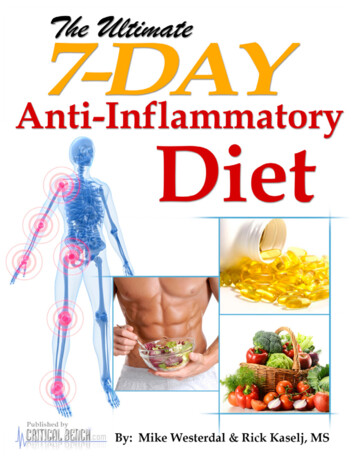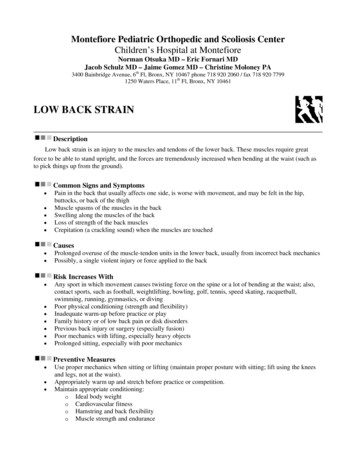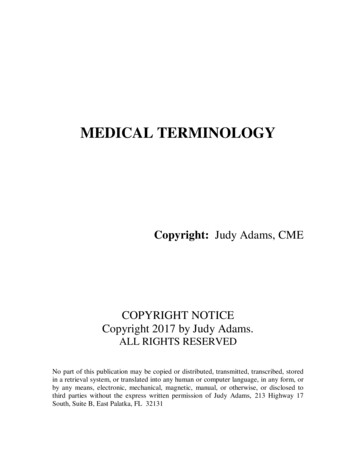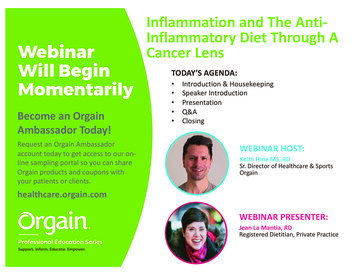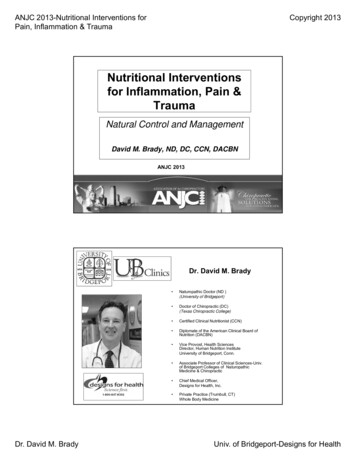
Transcription
ANJC 2013-Nutritional Interventions forPain, Inflammation & TraumaCopyright 2013Nutritional Interventionsfor Inflammation, Pain &TraumaNatural Control and ManagementDavid M. Brady, ND, DC, CCN, DACBNANJC 2013Dr. David M. BradyDr. David M. Brady Naturopathic Doctor (ND )(University of Bridgeport) Doctor of Chiropractic (DC)(Texas Chiropractic College) Certified Clinical Nutritionist (CCN) Diplomate of the American Clinical Board ofNutrition (DACBN) Vice Provost, Health SciencesDirector, Human Nutrition InstituteUniversity of Bridgeport, Conn. Associate Professor of Clinical Sciences-Univ.of Bridgeport Colleges of NaturopathicMedicine & Chiropractic Chief Medical Officer,Designs for Health, Inc. Private Practice (Trumbull, CT)Whole Body MedicineUniv. of Bridgeport-Designs for Health
ANJC 2013-Nutritional Interventions forPain, Inflammation & TraumaCopyright 2013Pain and Inflammation– Standard allopathic medicinecommonly treats the pain of injurywith non-steroidal anti-inflammatorydrugs, or NSAIDs.Almekinders, LC. The Efficacy of non-steroidal anti-inflammatory drugs in thetreatment of ligament injuries. Sports Medicine 1993;9(3):137-42.NSAID’s GI bleeding“The risk of upper GI bleeding is 3to 4-fold higher in people takingNSAIDs than those not”.Rodriguez LAG and Jick H. Risk of upper gastrointestinal bleeding and perforation associatedwith individual non-steroidal anti-inflammatory drugs. Lancet 1994;343:769-72Dr. David M. BradyUniv. of Bridgeport-Designs for Health
ANJC 2013-Nutritional Interventions forPain, Inflammation & TraumaCopyright 2013“A large majority of patients with serious GIcomplications due to NSAIDs do not even havepreceding mild side effects.”Arch Inter Med. Vol. 156;1530-1536; July 1996NSAID’sThe chronic use of NSAIDmedications has been linked toincreased intestinal permeabilityand inflammation in arthritisBjarnason I, et al. Intestinal permeability and inflammation in rheumatoid arthritis:effects of non-steroidal anti-inflammatory drugs. Lancet 1984;1171-1174Dr. David M. BradyUniv. of Bridgeport-Designs for Health
ANJC 2013-Nutritional Interventions forPain, Inflammation & TraumaCopyright 2013Jaques P, Elewaut D.Joint expedition: linking gutinflammation to arthritis.Mucosal Immunology.Vol 1,No 5, Sept. 2008Jaques P, Elewaut D.Joint expedition: linking gutinflammation to arthritis.Mucosal Immunology.Vol 1,No 5, Sept. 2008Dr. David M. BradyUniv. of Bridgeport-Designs for Health
ANJC 2013-Nutritional Interventions forPain, Inflammation & TraumaCopyright 2013“In ankylosing spondylitis (AS) the incidence of gutinflammation was significantly higher in patientswith combined peripheral joint arthritis (70%) thanin those with axial involvement alone (34%) gutinflammation was found in 70% of the cases These findings provide further arguments jointdisease is triggered through the gut.”J Rheumatology, 1990;8:523-524“NSAID’s can have profound effects on renalfunction .The therapeutic action of NSAID’s isbased upon the inhibition of COX. Renalprostaglandins serve a critical role in regulatingtubular function”Managing Chronic Pain. 17-22Courtesy of Bill ShaddleDr. David M. BradyUniv. of Bridgeport-Designs for Health
ANJC 2013-Nutritional Interventions forPain, Inflammation & TraumaCopyright 2013Synthetic Modulation of Arachidonic Acid CascadeCell MembraneCortisonePhospholipase A2Arachidonic AcidIndomethacinAspirinIbuprofenAcetaminophen (weak)Sulfasalazine (topically)cyclooxygenase lipooxygenaseSulfasalazine (topically)2 ColchicineCourtesy of Bill ShaddleCOX-2 specific antiinflammatory medications What happened?– VIOXX– Celebrex– BextraDr. David M. BradyUniv. of Bridgeport-Designs for Health
ANJC 2013-Nutritional Interventions forPain, Inflammation & TraumaCopyright 2013Cyclooxegenase pathways (COX)and anti-inflammatory andard NSAID medicationsCOX-1MoreInhibitionDr. David M. BradyCOX-2Univ. of Bridgeport-Designs for Health
ANJC 2013-Nutritional Interventions forPain, Inflammation & TraumaCopyright 2013COX-2 specific anti-inflammatory medicationsCOX-1COX-2MuchMoreInhibitionDr. David M. BradyUniv. of Bridgeport-Designs for Health
ANJC 2013-Nutritional Interventions forPain, Inflammation & TraumaCopyright 2013Corticosteroids Side effects– Osteoporosis– Muscle weakness; myopathy– Impaired wound healing– Impaired immune function– Peptic ulcer; gut perforation– etc., etc., etc.Physicians’ Desk Reference, 49 ed., 1995Strategies in Pain andInflammation Management Modulating prostaglandin and leukotrienecycles Replacing the need for NSAID medications Providing pain relief without destroyingintestinal healthDr. David M. BradyUniv. of Bridgeport-Designs for Health
ANJC 2013-Nutritional Interventions forPain, Inflammation & TraumaCopyright 2013Synthetic Modulation of Arachidonic Acid CascadeCell MembraneCortisonePhospholipase A2Arachidonic AcidIndomethacinAspirinIbuprofenAcetaminophen (weak)Sulfasalazine (topically)cyclooxygenase lipooxygenaseSulfasalazine (topically)2 ColchicineCourtesy of Bill ShaddleModulation of Arachidonic Acid CascadeHesperidin/quercetinCell membrane stabilizingCell MembraneQuercetinCurcuma longapotentiates CortisolPhospholipase A2Arachidonic Acid(AA)GingerCurcuma longaQuercetin (weak) AspirinIbuprofencyclooxygenase lipooxygenaseProstaglandinsSeries 2ThromboxaneA2QuercetinCurcuma longaBoswellia serrataLeukotrienesSeries 4Courtesy of Bill ShaddleDr. David M. BradyUniv. of Bridgeport-Designs for Health
ANJC 2013-Nutritional Interventions forPain, Inflammation & TraumaCopyright 2013 Turmeric(Curcuma longa) Inhibits leukotrienebiosynthesis.Bisset, NG, ed. Herbal drugs andphytopharmaceuticals. Boca Raton: CRC Press,1994:173-5Turmeric(Curcuma longa)Dr. David M. BradyUniv. of Bridgeport-Designs for Health
ANJC 2013-Nutritional Interventions forPain, Inflammation & TraumaCopyright 2013–Ginger(Zingiber officinale) Also has inhibitoryeffect onprostaglandinsynthesis.Bisset, NG, ed. Herbal drugs andphytopharmaceuticals. Boca Raton: CRC Press,1994:537-9Botanical Modulation of Arachidonic Acid CascadeCell MembraneGlycyrrhiza glabraQuercetinPotentiates cortisol:Glycyrrhiza glabraCurcuma longaPhospholipase A2Arachidonic Acid(AA)Zingiber officinaleCurcuma longaQuercetin (weak)Ananas comosusSalix nigra / albaGaultheria procumbenscyclooxygenaseProstaglandinsSeries 2QuercetinAllium cepaAllium sativumCurcuma longaBoswellia ific for 5lipoxygenase)Other Anti-Inflammatory BotanicalsAnanas comosus -- fibrinolysis, inhibits bradykinin, increases Series I ProstaglandinsTanacetum parthenium -- inhibits platelet aggregationMatricaria chamomilla -- unknownScutellaria baicalensis -- stabilizes mast cell membranesCapsicum minimum -- depletes substance PQuercetin -- stabilizes mast cell membranesAmmi visnaga -- stabilizes mast cell membranes:Courtesy of: Eleanor Barrager, RD (Australia) and The Institute for Functional MedicineDr. David M. BradyUniv. of Bridgeport-Designs for Health
ANJC 2013-Nutritional Interventions forPain, Inflammation & TraumaCopyright 2013Fatty acid manipulation Consuming a diet high in certain fattyacids that compete with arachidonicacid for binding sites, or that producemediators less inflammatory than thosefrom arachidonic acid, can producepotent anti-inflammatory effects.Hecker, M. et al. The eicosanoids: prostaglandins, thromboxanes, leukotrienes, and relatedcompounds. In: Katzung, BG, ed. Basic and Clinical Pharmacology, 6th ed.Norwalk, CT:Appleton and Lange, 1995:290-304Changing fatty acid intake:omega-6: omega-3 ratios1:1Dr. David M. Brady4:125:1Univ. of Bridgeport-Designs for Health
ANJC 2013-Nutritional Interventions forPain, Inflammation & TraumaCopyright 2013Metabolic Pathways of Essential Fatty AcidsOmega-3 Fatty Acids (N3)Omega-6 Fatty Acids (N6)(e.g.,flax seed, hemp, canola, soybean, walnut)(e.g., canola, corn, soybean, safflower, sunflower oils)Alpha-Linolenic Acid (LNA)CIS Linoleic Acid (LA)-6 desaturase-6 desaturaseGammaBorage oilBlack currant seed oilEvening primrose oilelongaseDi-Homo-Gamma- Linolenic Acid(DGLA)Mothers’ breast milkAnimalfats in diet-5 desaturaseArachidonic Acid (AA)elongaseSeries 1 Prostaglandins,Leukotrienes, andThromboxanesEicosatetraenoic Acid-5 desaturaseSeries 3 Prostaglandins,Leukotrienes, andThromboxanesEicosapentaenoic Acid (EPA)DocosapentaenoicAcidAdrenic Acid-4 desaturase-4 desaturaseDocosapentaenoic AcidVitamin E, C (stabilizemembrane)Fish OilselongaseSeries 2 Prostaglandins,Leukotrienes, andThromboxaneselongaseBlackcurrantseed oilStearidonic AcidLinolenic Acid (GLA)Docasahexaenoic Acid (DHA)Fish OilsMarinealgaeCell Membranedihomo-y-linolenic acid (DGLA)Vitamin EPhospholipase A2Delta 5desaturaseEPAArachidonic AcidEPA substratecompetitionEPA substrate aselipooxygenase2 Series ThromboxaneProstaglandins A2LeukotrienesSRS-AEPAVitamin EGS-PxLeukotrienesSRS-AVitamin EGS-PxNutrient Modulation ofArachidonic Acid CascadeCourtesy of Bill ShaddleDr. David M. BradyUniv. of Bridgeport-Designs for Health
ANJC 2013-Nutritional Interventions forPain, Inflammation & TraumaCopyright 2013Fatty Acid AnalysisBlood Spot Sample CollectionDr. David M. BradyUniv. of Bridgeport-Designs for Health
ANJC 2013-Nutritional Interventions forPain, Inflammation & TraumaCopyright 2013Metabolic Pathways of Essential Fatty AcidsOmega-3 Fatty Acids (N3)Omega-6 Fatty Acids (N6)(e.g., canola, corn, soybean, safflower, sunflower oils)CIS Linoleic Acid (LA)Low Zinc?-6 desaturaseGammaBorage oilBlack currant seed oilEvening primrose oilelongaseMothers’ breast milkAnimalfats in diet-5 desaturaseArachidonic Acid (AA)elongaseAlpha-Linolenic Acid (LNA)-6 desaturaseStearidonic AcidLinolenic Acid (GLA)Di-Homo-Gamma- Linolenic Acid(DGLA)(e.g.,flax seed, hemp, canola, soybean, walnut)Series 1 Prostaglandins,Leukotrienes, andThromboxaneselongaseBlackcurrantseed oilEicosatetraenoic Acid-5 desaturaseSeries 3 Prostaglandins,Leukotrienes, andThromboxanesSeries 2 Prostaglandins,Leukotrienes, andThromboxanesAdrenic Acid-4 desaturaseDocosapentaenoic AcidEicosapentaenoic Acid (EPA)Fish OilselongaseDocosapentaenoicAcid-4 desaturaseDocasahexaenoic Acid (DHA)Fish OilsMarinealgaeProteolytic enzymesAnti-inflammatory and supports thehealing process Suggested modes of action:– Destroy/inactivate bradykinins & histamine– Reduce viscosity of extracellular fluid– Molecular debridementBucci, L. Nutrition applied to Injury Rehabilitation and sports medicine. Boca Raton:CRCpress, 1995:167-75Dr. David M. BradyUniv. of Bridgeport-Designs for Health
ANJC 2013-Nutritional Interventions forPain, Inflammation & TraumaCopyright 2013Proteolytic enzymes Oral trypsin and chymotrypsin haveshown in trials including thousands ofpatients to be effective in helpingcontrol pain and inflammation andreducing time lost due to injury.Christie, RB. The medical uses of proteolytic enzymes. In: Wiseman A, ed. Topics in Enzymeand Fermentation Biotechnology. Chichester, England, Ellis Horwood Ltd., 1980:25-83.Proteolytic enzymes 55 injured boxers were given oraltrypsin/chymotrypsin tablets. Theircuts and abrasions healed an averageof twice as fast as those taking aplacebo, and they were able to resumeboxing in one week.Blonstein JL. Oral enzyme tablets in the treatment of boxing injuries. Practitioner1967;198:547-8Dr. David M. BradyUniv. of Bridgeport-Designs for Health
ANJC 2013-Nutritional Interventions forPain, Inflammation & TraumaCopyright 2013Proteolytic enzymes 100 patients entered a double blindplacebo-controlled trial of proteolyticenzymes in hand fractures. Results: a statistically significantimprovement in the recovery rate, withno side effects.Shaw, PC. The use of trypsin-chymotrypsin formulation in fractures of the hand. The BritishJournal of Clinical Practice 1969;23(1);25-6MSM for Inflammation & Healing MSM makes cortisol effective at lower doses Histamine regulator – prevents histamine fromcausing inflammation, swelling, fluid build-up Excess fibroblasts are produced in the swellingprocess and lead to scar tissue MSM inhibits proliferation of fibroblasts MSM binds to fluid in swollen tissue and aids in itsremovalDr. David M. BradyUniv. of Bridgeport-Designs for Health
ANJC 2013-Nutritional Interventions forPain, Inflammation & TraumaCopyright 2013Laboratory Assessment inInflammatory Conditions Erythrocyte Sedimentation Rate (ESR)C-Reactive Protein (CRP)LeukocytosisNeutrophiliaFerritinRheumatoid factorANAAA/EPA RatioNutritional Management ofInflammation (General) Herbals: (2 tabs q4h in acute phase)– Boswellia: 400mg– Tumeric (Curcumin): 300mg– Ginger (Zingiber): 200mg Bioflavonoids: (250mg mixed/day)– Quercetin, Hesperidin, Rutin, etc. Proteolytic Enzymes: (3-4 tabs qid in between meals)– Protease, Trypsin, Chymotrypsin, Bromelain, Papain, etc. MSM: (1-2 gm/day) EFA(500 mg-1 gm per day) AntioxidantsDr. David M. BradyUniv. of Bridgeport-Designs for Health
ANJC 2013-Nutritional Interventions forPain, Inflammation & TraumaCopyright 2013InflammationSample Anti-inflammatory Formulation Protease 6.0 . 50,000 HUTProtease 4.5 . 40,000 HUTTrypsin 1:150 . 25 mgSerrazimes . 10,000 UChymotrypsin . . 2 USP UnitsQuercitin . . .75 mgRutin . .75 mgBoswellia (60% Bosw. acids) .200 mgTurmeric (.95% Curcum.) . .200 mgGinger (5% gingerols) . 200 mgRosemary . .50 mgResveratrol .3 mgSample Chronic Joint Pain FormularyAmounts per servingServing size4 capsulesNumber of servings per container30Vitamin B3 (Niacinamide)500 mg.N-Acetylcysteine (NAC)200 mgGlucosamine Sulfate (KCL stabilized)1000 mg.MSM (methyl sulfonyl methane)750 mg.Boswellia serrata resin(60% Boswellic acid)75 mg.Turmeric (Curcuma longa)(95% curcuminiods)75 mgResveratrol (Polygonum cusp.)(20% Resveratrol)3 mg.Green Lipped Mussel100 mgHyaluronic acid20 mgCetyl Myristoleate30 mg.Zinc (Chelazome)10 mg.Copper (chelate)1 mg.Manganese (Chelazome)1 mg.Selenium (selenomethionine)200 mcg.Suggested Dose: Take 4 capsules daily, or as directed by your health care practitioner.Dr. David M. BradyUniv. of Bridgeport-Designs for Health
ANJC 2013-Nutritional Interventions forPain, Inflammation & TraumaCopyright 2013FlavocoxidFlavocoxidDr. David M. BradyUniv. of Bridgeport-Designs for Health
ANJC 2013-Nutritional Interventions forPain, Inflammation & TraumaCopyright 2013FlavocoxidDIETANTIOXIDANTFlavocoxidDr. David M. BradyUniv. of Bridgeport-Designs for Health
ANJC 2013-Nutritional Interventions forPain, Inflammation & TraumaCopyright 2013Arachidonic Acid MetabolismNo TreatmentTraditional NSAIDsAACOX-1COX-2COX-2 5-LOXUlcerationEdemaDyspepsiaHypertensionRenal DysfunctionCV DysfunctionBurnett et al., 2006Flavocoxid Restores BalanceIncreasedDietary AACOX-1COX-25-LOXFEWER Side Effects, LESS OADr. David M. BradyUniv. of Bridgeport-Designs for Health
ANJC 2013-Nutritional Interventions forPain, Inflammation & TraumaCopyright 2013Antioxidant, genomic activity of flavocoxid Regulatory Proteins and mRNA: p38 JUNK NF B All of these proteinsare involved in a I Bα (regulates NF B activation)variety of chronic Cytokine mRNA and Protein:diseasesincluding IL-1β osteoarthritis IL-6 TNFα Burnett et al., 2007 Enzyme mRNA and Protein:Altavilla et al., 2009 COX-2 (celecoxib and ibuprofen increase COX-2)Messina et al., 2009 5-LOX Tseng-Crank et al., 2008, 2010Polito et al., 2010 iNOS Burnett et al., 2011NSAIDs vs. FlavocoxidHigher Side EffectsCOX-1, COX-2Lower Side EffectsDr. David M. BradyPLA2, COX-1, COX-2, 5-LOX,NF B, JNK, p38, reactiveoxygen species, cytokinesUniv. of Bridgeport-Designs for Health
ANJC 2013-Nutritional Interventions forPain, Inflammation & TraumaCopyright 2013FlavocoxidFlavocoxidDr. David M. BradyUniv. of Bridgeport-Designs for Health
ANJC 2013-Nutritional Interventions forPain, Inflammation & TraumaCopyright 2013FlavocoxidDr. David M. BradyUniv. of Bridgeport-Designs for Health
ANJC 2013-Nutritional Interventions forPain, Inflammation & TraumaCopyright 2013Coagulation Safety Summary An animal trial shows no interaction withaspirin Human platelet function study shows noaffect on platelet aggregation, no effect onthromboxane levels (as predicted by theMOA of Flavocoxid) and no effect on bleedtime. Human warfarin study shows no interactionwith flavocoxid over a 2 week period Safe to take with baby aspirin and warfarinas long as monitored as usually doneFlavocoxid Conclusion Flavocoxid modulates COX-1 and COX-2equally as well as 5-LOX to damp AAmetabolism Flavocoxid has a strong antioxidant effectwhich modulates other inflammatorypathways and soaks up antioxidants whichdamage cartilage Flavocoxid is a small hammer on manypathways, while NSAIDs are a hammer onone. This leads to better safety with the same,long-term efficacyDr. David M. BradyUniv. of Bridgeport-Designs for Health
ANJC 2013-Nutritional Interventions forPain, Inflammation & TraumaCopyright 2013Post-Traumatic Head InjuryHead Trauma Incidence:Age & Gender MattersBordignon KC, Oleschko Arruda W. CT SCAN FINDINGS IN MILD HEAD TRAUMA: A series of 2,000 patientsArq. Neuro-Psiquiatr. vol.60 no.2A São Paulo June 2002.Dr. David M. BradyUniv. of Bridgeport-Designs for Health
ANJC 2013-Nutritional Interventions forPain, Inflammation & TraumaCopyright 2013Head Trauma CausesThe most common causes of head injury were aggression (17.9%), falls (17.4%),automobile accidents (16.2%), falls to the ground (13.1%) and pedestrians injuries(13%) (Fig 2). The medium age for each group of causes varied from 21 to 44 years.Bordignon KC, Oleschko Arruda W. CT SCAN FINDINGS IN MILD HEAD TRAUMA: A series of 2,000 patientsArq. Neuro-Psiquiatr. vol.60 no.2A São Paulo June 2002.Head Trauma Cause:Age and Gender MattersThere was a pronounced difference in the distribution of causes according to ageand gender (Table 1).Bordignon KC, Oleschko Arruda W. CT SCAN FINDINGS IN MILD HEAD TRAUMA: A series of 2,000 patientsArq. Neuro-Psiquiatr. vol.60 no.2A São Paulo June 2002.Dr. David M. BradyUniv. of Bridgeport-Designs for Health
ANJC 2013-Nutritional Interventions forPain, Inflammation & TraumaCopyright 2013Head Trauma Cause:Alcohol MattersBordignon KC, Oleschko Arruda W. CT SCAN FINDINGS IN MILD HEAD TRAUMA: A series of 2,000 patientsArq. Neuro-Psiquiatr. vol.60 no.2A São Paulo June 2002.Head Trauma ComplicationsBordignon KC, Oleschko Arruda W. CT SCAN FINDINGS IN MILD HEAD TRAUMA: A series of 2,000 patientsArq. Neuro-Psiquiatr. vol.60 no.2A São Paulo June 2002.Dr. David M. BradyUniv. of Bridgeport-Designs for Health
ANJC 2013-Nutritional Interventions forPain, Inflammation & TraumaCopyright 2013GPC: GlycerophosphocholinePSGPCLeft: Molecular organization of PC (phosphatidylcholine). Right: Molecularorganization of GPC. Note the GPC molecule lacks the two fatty acid “tails” of PC.Benefits of GPC:“glycerophosphocholine” Naturally occurring in all our cells andmother’s milk “active” form of choline – has an addedphosphate and glycerol group Water soluble and can cross the blood brainbarrier (PC cannot) Can more directly make acetylcholineDr. David M. BradyUniv. of Bridgeport-Designs for Health
ANJC 2013-Nutritional Interventions forPain, Inflammation & TraumaCopyright 2013Benefits of GPC:“glycerophosphocholine” Structure-function synergy with DHA, afavored substrate for combination with theomega-3 fatty acid (docosahexaenoic acid)to make omega-3 phosphatidylcholine (PCDHA) that helps build highly fluid cellmembranes. Such molecules are especiallyutilized by the most metabolically activetissues such as brain gray matter, retina,skeletal muscle, and spermatozoa.Research on GPC Improvements in attention, mental focus andcognition whether linked to Alzheimer’s orpoor brain circulation Brain recovery following stroke or otherinjury Revitalizes master hormone functions viapituitary control, especially in the elderly(growth hormone)Dr. David M. BradyUniv. of Bridgeport-Designs for Health
ANJC 2013-Nutritional Interventions forPain, Inflammation & TraumaCopyright 2013Research on GPC Studiesused 1200 mg per day in dividedGPC dosesdoses. The largest stroke trial in Italy, 2000patients, GPC helped 95% to improve. GPC outperforms other cholinergicprecursors Better than choline, PC, and cytosinediphosphocholine (known as CDP choline)GPC to recover from strokealpha-Glycerophosphocholine in the mental recovery of cerebral ischemicattacks. An Italian multicenter clinical trial.Barbagallo Sangiorgi G, Barbagallo M, Giordano M, Meli M, Panzarasa R.Institute of Internal Medicine and Geriatrics, University of Palermo, Italy.–––––The clinical efficacy and the tolerability of alpha-glycerophosphocholine (alpha-GPC),able to provide high levels of choline for the nervous cells of the brain and to protecttheir cell walls, have been tested in a clinical open multicenter trial on 2044 patientssuffering from recent stroke or transient ischemic attacks (TIA).GPC was administered after the attack at the daily dose of 1000 mg im for 28 days andorally at the dose of 400 mg tid during the following 5 months after the first phase.(1200 mg/day oral)the MMST (Mini Mental State Test) mean significantly increased from 21 to 24.3 at theend of the trial, reaching the "normality" score at the 3rd month assessment.The GDS score at the end of the trial corresponded to "no cognitive decline" or"forgetfulness" in 71% of the patients.The trial confirms the therapeutic role of alpha-GPC on the cognitive recovery ofpatients with acute stroke or TIA, and the low percentage of adverse events confirmsits excellent tolerability.Ann N Y Acad Sci. 1994 Jun 30;717:253-69.Dr. David M. BradyUniv. of Bridgeport-Designs for Health
ANJC 2013-Nutritional Interventions forPain, Inflammation & TraumaCopyright 2013GPC works better than CDP cholineA multicentre trial to evaluate the efficacy and tolerability ofalpha-glycerylphosphorylcholine versus cytosinediphosphocholine in patients with vascular dementia.Di Perri R, Coppola G, Ambrosio LA, Grasso A, Puca FM, Rizzo M.First Neurological Clinic, University of Messina, Italy.– An open clinical trial was carried out to compare the efficacy and thetolerability of 1 g/day alpha-glycerylphosphorylcholine (alpha-GPC) with 1g/day cytosine diphosphocholine (CDP) both given intramuscularly for 90days in 120 patients with mild to moderate vascular dementia.– The clinical evaluation, carried out at the start as well as halfway through(45 days) and at the end of treatment (90 days), was expressed bypsychometric tests (modified Parkside behaviour rating scale, Sandozclinical assessment geriatric scale, word fluency test, Hamilton's ratingscale of depression, narration subtest of Wechsler memory scale).– Both treatments produced a definite symptomatic improvement andshowed a very good tolerability. The results suggest that in most tests alphaGPC possessed a statistical higher efficacy and an overall more satisfactoryactivity assessed by both patients and investigators compared with CDP.J Int Med Res. 1991 Jul-Aug;19(4):330-41.GPC for amnesiaL-alpha-glycerylphosphorylcholine antagonizes scopolamine inducedamnesia and enhances hippocampal cholinergic transmission in therat.Sigala S, Imperato A, Rizzonelli P, Casolini P, Missale C, Spano P.Institute of Pharmacology and Experimental Therapeutics, School of Medicine, University of Brescia,Italy. The effects of GPC on scopolamine-induced memory impairment and on brainacetylcholine (ACh) synthesis and release were investigated in rats.Oral administration of alpha-GPC 3 h before the behavioral test prevented thelearning impairment induced by scopolamine given 30 min before theacquisition of a passive avoidance response.Amnesia induced by scopolamine, given immediately after acquisition training,was also completely reversed by GPC.These effects were dose-dependent with a maximum at 300 mg/kg.The mechanism of action of this compound was investigated by measuringhippocampal ACh synthesis and release both in vivo by means of the microdialysistechnique and in vitro in tissue slices.GPC dose dependently increased ACh release with a maximum at 300 mg/kg.In addition, i.v. injection of [14C]alpha-GPC resulted in [14C]ACh formation.The data suggest that the behavioural effects of alpha-GPC may be related toits property to increase hippocampal ACh synthesis and release.Eur J Pharmacol. 1992 Feb 18;211(3):351-8.Dr. David M. BradyUniv. of Bridgeport-Designs for Health
ANJC 2013-Nutritional Interventions forPain, Inflammation & TraumaCopyright 2013Premier Brain NutrientsAlpha-lipoic acid .300-2,400 mgAcetyl-L-carnitine 1-3 gmCoenzyme Q10 . 360–2,400 mgEPA DHA .800-3,000 mgGlycerophosphocholine 600-1,200 mgPhophatidylserine .100-500 mgNADH . 5-15 mgKidd PM. Neurodegeneration from mitochondrial insufficiency: Nutrients, stem cells, growth factors, andprospects for brain rebuilding using integrative medicine. Alternative Medicine Review, Vol. 10, No. 4, 2005(268-293).Premier Brain NutrientsThese new data further characterize the neuroprotective effectsof carnosine (beta-alanyl-L-histadine) and suggest that carnosinemay be an attactive candidate for testing as a stoke therapy.Brain Health 450-1,000 mg qdPost-Stroke . 2.5–5 gm qdMin J., Senut MC, Rajanikant K, et al. Differential neuroprotective effects of carnosine, anserine, and Nacetyl carnosine against permanent focal ischemia. J Neurosci Res. 2008 Jun 9.Dr. David M. BradyUniv. of Bridgeport-Designs for Health
ANJC 2013-Nutritional Interventions forPain, Inflammation & TraumaCopyright 2013Brain Oxygenation Enhancement Dimethylglycine (DMG) / Trimethylglycine (TMG) Ginkgo bilobaBreakDr. David M. BradyUniv. of Bridgeport-Designs for Health
David M. Brady, ND, DC, CCN, DACBN ANJC 2013 Dr. David M. Brady Naturopathic Doctor (ND ) (University of Bridgeport) Doctor of Chiropractic (DC) (Texas Chiropractic College) Certified Clinical Nutritionist (CCN) Diplomate of the Amer ican Clinical Board of Nutrition (DACBN) Vice Provost, Health Sciences



